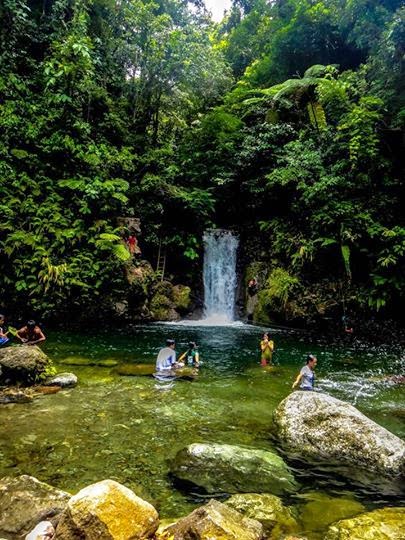Earlier known as Mambulao, the town of Jose Panganiban,Camarines Norte, earned it's sublime reputation in national history not only as one of the most abundant sources of gold in the islands but also as the birthplace of one of the most brilliant members of Propaganda Movement in Spain. As a tribute to their most heroic son, the town thus was renamed Jose Panganiban.

Jose Maria Panganiban y Enverga (1 February 1863- August 19,1890)
a Bicolano Propagandist, linguist, and essayist whose life was a tragically cut short. An event that caused great mourning for Bicolanos and in the Filipino community living in Spain. He is one of the main writer and contributor of La Solidaridad, writing under the pen names "JoMaPa" and "J.M.P."
He was born in Bangkal Phase II, Jose Panganiban, Camarines Norte. He was the eldest of the three boys of Don Vicente Panganiban, a native Hagonoy Bulacan and Doña Juana Vicente Enverga of Mauban, Tayabas (now Quezon).
Oral accounts claimed that Pepe, as Jose was fondly referred to by his acquaintances, was but a lad of four when his mother recognized his genius. Spending her evenings often as late as 9 o'clock teaching him the alphabet, Juana was surprised to learn that the precocious boy,after a month's tutoring, cloud read such materials as the Cartilla and Catesismo. Often times Pepe was found ransacking his father's books for additional reading materials.One time he was found by his mother sleeping under a tree with Cervantes' Don Quixote in his hand.
When he reached the age of eight, Father Francisco Fernandez brought him to Labo where he learned the Spanish language. The following year he transferred to Daet (capital town of Camarines Norte) to study under a certain Teodoro Avila. It was during this time that he painted the picture of San Antonio de Padua which earned the admiration of both Bicolanos and Spaniards.
In 1873, Panganiban went to Nueva Caceres and enrolled in the seminary college where, he excelled as a student, receiving grades of straight sobresalientes (excellent). As an eminent orator, the seminary chose him to deliver a speech in honor of their distinguished guest, Governor General Moriones. The Governor General was so pleased and impressed but his eloquence that he pinned a medal on Pepe.
His inclination to medicine was discovered early by his teachers who appointed him as assistant in College of Physicians when he is fifteen years old. He was tasked to treat his fellow students with minor ailments. Having a complete his secondary education in the seminary, Panganiban left Nueva Caceres in 1882 and went to Manila where he enrolled in University of Santo Tomas, completing his preparatory medicine with honors. Two years later he enrolled in the College of Medicine.
 In May 1888, he sailed to Spain to continue his studies in University of Barcelona but abandoned them because the Filipino cause caught his interest. Joining the illustrious staff of the La Solidaridad, Panganiban was appointed as essayist and translator and wrote under the pen name "JOMAPA" or "J.M.P." He was also an activist member of the Association Hispano-Filipino in Madrid.
In May 1888, he sailed to Spain to continue his studies in University of Barcelona but abandoned them because the Filipino cause caught his interest. Joining the illustrious staff of the La Solidaridad, Panganiban was appointed as essayist and translator and wrote under the pen name "JOMAPA" or "J.M.P." He was also an activist member of the Association Hispano-Filipino in Madrid.
Admired by his colleagues as a talented speaker even by no less than the eminent national hero, Jose Rizal, this spoke with pride of this eloquence. "He took advantage of all occasions to speak... at banquets, and meetings, he lets his voice ring, delivering eloquent speeches that were listened to with enthusiasm and general approval. Panganiban was a true orator, of easy and energetic words, vigorous concepts, and practical transcendental ideas."
Panganiban's patriotism remained unshaken by difficulties and sickness which continually haunted him in Spain. In his sickbed he wrote to Jose Rizal, "I regret I cannot be with you in your patriotic labor for the redemption of our fatherland...If only I have the strength I had before, I will work with you unto the bitter end." He had contracted a pulmonary ailment while in Spain, and died on August 19, 1890.
A serious blow to the nationalist crusade being waged by the propaganda movement in the Spanish soil. Rizal wrote a eulogy summarizing JOMAPA's immense contribution which his demise brought to sudden end:
" A hope vanished, a talent wasted, an entire youth consecrated to study for a useful and fruitful maturity-- all this the Philippines lament and those of us who know you. But what Panganiban should cry about even in the confines of the grave is that he died without accomplishing the lofty mission to which his exceptional qualities destined him for; the thought he died without being ale to give beforehand his blood and thoughts-- all to the noble cause he had begun to undertake. We who are left behind can only honor his memory by filling the vacuum he had left. His great satisfaction will not be tears but deeds; not for him, but for his country."
















